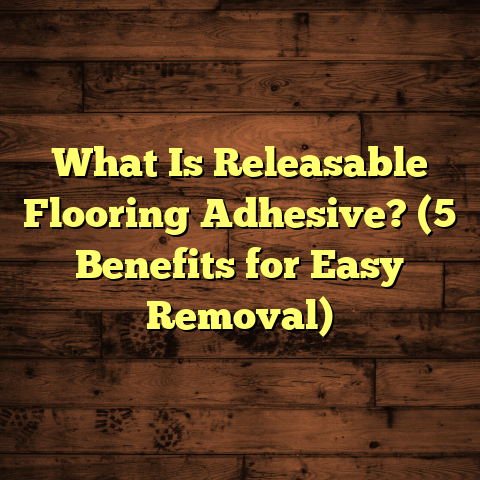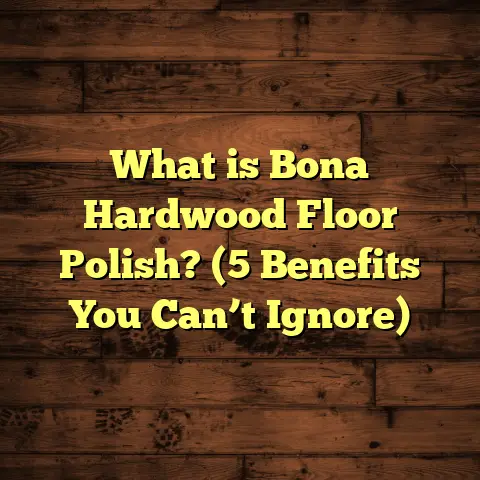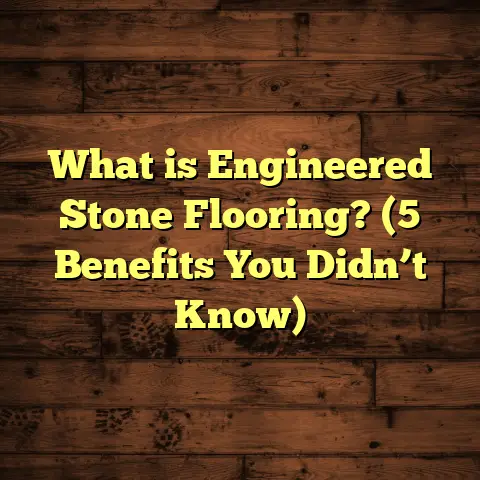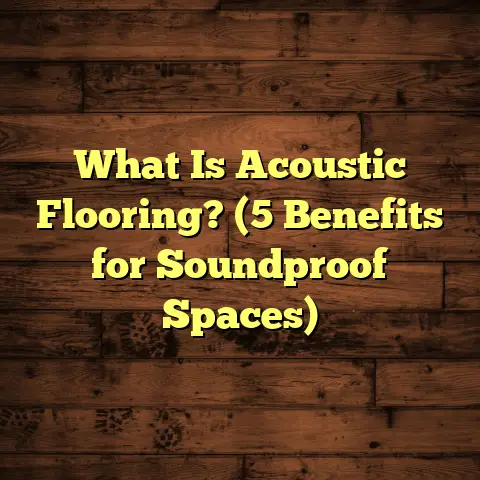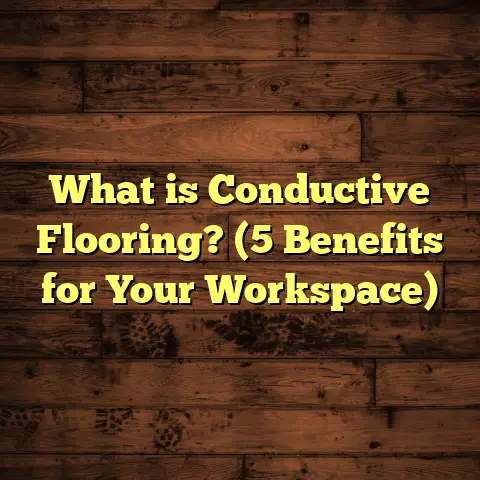What is Causing My Carpet to Bulge? (5 Key Issues Revealed)
I remember watching that classic scene in The Shining, where the carpet in the hotel looked like it had a mind of its own, bulging and rippling eerily across the floor. It always gave me chills — but it also got me thinking about what actually causes carpets to bulge in real life. As someone who’s been knee-deep in flooring for over a decade, I’ve seen my fair share of bulging carpets and all the headaches that come with them. So, if you’ve noticed a weird lump under your feet or a bulge creeping up in your living room carpet, you’re definitely not alone.
Let me walk you through what’s really going on beneath those bumps, share some stories from the trenches, and help you figure out how to keep your floors looking smooth and safe.
What Is Carpet Bulging?
Carpet bulging is when your carpet surface lifts or puckers instead of lying flat against the floor. You might see raised areas that look like wrinkles, bubbles, or lumps. It’s not just an eyesore; it can cause tripping hazards and damage the carpet’s fibers over time.
Think of your carpet like a drum skin. If it’s stretched tight, it sounds right. But if it loosens or gets bumped from underneath, it puffs up and sounds off. Same idea with carpet bulges.
The carpet is supposed to be stretched tightly over a padding layer and anchored securely along the edges—either with tack strips nailed into the floor or by glue. When this tension is lost or something pushes up from underneath, bulges form.
Bulging can appear anywhere on the carpet but is most common along edges or in high-traffic areas where the carpet has been stressed or moisture has seeped in.
Why Should You Care About Carpet Bulging?
Besides looking ugly, carpet bulges can cause trips and falls — especially dangerous for kids and older adults. Over time, the raised areas can wear out faster, leading to fiber damage or even tears in the carpet backing.
Fixing bulges early can save you from costly repairs or total carpet replacement down the road.
What Causes Carpet Bulging? The 5 Key Issues
After years of hands-on experience and plenty of troubleshooting, I’ve learned that most carpet bulging can be traced to five major causes. Each one tells a different story about what’s going on beneath your feet.
Let’s break these down one by one, including some real cases I’ve worked on and data from flooring studies.
1. Poor Installation or Stretching Problems
This is probably the single biggest reason behind carpet bulges. When carpets are installed, they need to be stretched tightly over the padding and secured correctly at the edges — usually with tack strips nailed into the floor perimeter.
If this step isn’t done right, the carpet can start to loosen and wrinkle as you walk on it.
My Experience
I remember a job where a homeowner called me within a month of having new carpet installed. The entire living room had these massive waves and ripples. Upon inspection, it turned out the installer had skipped proper stretching — probably in a rush to finish before bad weather hit.
After re-stretching the carpet correctly with professional-grade tools, all the bulges disappeared. The client was relieved they didn’t have to replace their expensive carpeting.
Why Proper Stretching Matters
Carpet fibers don’t stretch much on their own. The stretching done during installation creates tension that keeps fibers straight and flat. Without this tension, daily foot traffic can cause the carpet to bunch up.
Data Point: Flooring industry reports indicate that improper stretching during installation causes about 60% of all carpet bulging issues within six months.
Signs It’s an Installation Issue:
- Bulges appeared soon after installation (within weeks to months).
- Bulges mainly along edges or seams.
- Carpet feels loose underfoot or shifts when you walk.
How Professionals Stretch Carpets
Pros use power stretchers that pull the carpet tight across the room, then secure it on tack strips nailed into the subfloor edges. This tension prevents wrinkles and bulges from forming.
DIY stretching with knee kickers often doesn’t achieve enough tension for larger rooms.
2. Moisture and Water Damage
Water is a silent but powerful enemy of carpets. It can come from spills, leaks, high humidity, or accidental flooding. When moisture seeps under your carpet into the padding or subfloor, it causes swelling and puckering that push up the carpet surface.
A Cautionary Tale
One of my clients had a central heating system leak hidden behind a wall for months. Nobody noticed until they found large bulges in their living room carpet along with a musty smell.
We discovered mold growing in the wet padding and some subfloor damage too. Moisture had caused the padding to expand unevenly under their feet, creating big lumps.
Fixing this involved replacing the padding and repairing the subfloor after drying everything thoroughly.
Why Moisture Causes Bulging
- Carpet padding absorbs water and swells.
- Subfloor wood expands when wet.
- Wet conditions cause adhesive failures if glued down.
- Mold growth weakens structural materials underneath.
Research Insight
According to multiple flooring studies:
- Water damage accounts for about 25% of all residential carpet bulging cases.
- Homes with humidity levels above 60% are at higher risk for moisture-related flooring problems.
- Mold growth underneath carpets is more common in basements and bathrooms where moisture is prevalent.
Preventive Tips
- Fix leaks immediately.
- Use dehumidifiers in damp basements.
- Avoid wet mopping carpets.
- Inspect plumbing near carpeted rooms regularly.
3. Worn Out Carpet Padding
The padding beneath your carpet acts like a cushion and support system. It helps absorb impact and keeps your carpet fibers in place.
But padding doesn’t last forever. Over years of heavy foot traffic, padding gets crushed or breaks down unevenly. This creates soft spots where the carpet sags or bulges above weak areas.
What I’ve Seen
In many older homes — especially those with original carpets still in place — I’ve noticed visible lumps caused by deteriorated padding.
One elderly client had a living room where kids played for decades on the same carpet. The padding had compressed so much that lumps appeared under their feet, making walking uncomfortable.
Replacing just the padding restored smoothness without needing new carpet.
Lifespan of Carpet Padding
- Most pads last between 8-10 years before losing effectiveness.
- Cheap padding can degrade faster (sometimes under 5 years).
- High-quality rubber or memory foam pads last longer but cost more upfront.
Why Padding Quality Matters
- Better padding distributes weight evenly.
- Good pads prevent premature wear on fibers.
- Inferior padding leads to lumps and bulges quicker.
4. Temperature Changes and Humidity Fluctuations
Carpets are made from fibers like nylon, polyester, or wool — materials that expand or contract slightly based on temperature and humidity changes.
Real-Life Example
I helped a client whose sunroom carpet developed wrinkles after just one summer. Temperatures inside ranged from chilly mornings to scorching afternoons due to poor insulation.
How Climate Affects Carpets
- Heat can make fibers expand.
- Cold causes contraction.
- Humidity affects padding moisture content.
- Rapid swings cause stress on seams and edges.
Case Study: Research from a flooring institute showed homes without climate control had 30% more reported carpet buckling during seasonal transitions compared to homes with HVAC systems maintaining stable indoor climates.
What You Can Do
- Use climate control systems (air conditioning/dehumidifiers).
- Keep humidity between 40%-60%.
- Avoid installing carpets in direct sunlight rooms without UV protection.
- Consider breathable pad materials for humid climates.
5. Subfloor Issues
Sometimes what looks like a carpet problem isn’t with the carpet at all but with what’s underneath — the subfloor.
Uneven floors, bumps, debris stuck under padding, or loose nails can all create pressure points pushing up your carpet surface into bulges or lumps.
A Memorable Case
A homeowner once called me about a suspicious bump near their doorway carpet. After lifting a corner carefully, we found a nail sticking up from an old subfloor board — likely left during previous renovations.
Removing the nail and leveling the floor underlay fixed the issue completely without needing new carpet or padding.
How Common Are Subfloor Problems?
Subfloor issues account for roughly 15% of reported carpet bulge problems based on homeowner surveys.
Common causes include:
- Loose nails or screws
- Warped wood planks
- Debris under padding (small rocks, dirt)
- Uneven concrete slabs in basements
- Water-damaged wood causing swelling/buckling
How to Check Your Subfloor
If you suspect subfloor issues:
- Carefully lift a small carpet corner near a bulge.
- Look for debris or raised nails.
- Use a straight edge tool to check floor evenness.
- Consult flooring pros for thorough inspection if unsure.
What Have I Learned Over the Years?
Fixing bulging carpets isn’t always quick or easy. Sometimes it’s as simple as re-stretching; other times it requires moisture remediation or subfloor repairs.
Here’s what I’ve found helpful:
Don’t Ignore Early Signs
Many people wait months before addressing bulges because they assume it’s cosmetic or temporary. But early action often means less expensive fixes — like re-stretching instead of full replacement.
Detailed Inspections Are Key
I never jump to conclusions until I inspect:
- The condition of padding
- Signs of moisture
- Subfloor quality
- Installation method used
- Environmental factors (humidity/temp)
This saves time and money by targeting root causes rather than symptoms.
Communication With Clients Matters
Sometimes clients want quick fixes or insist on blaming neighbors or pets! I make sure they understand possible causes clearly so decisions are informed.
Case Study: Saving a Family’s Carpet From Replacement
One family had a precious, high-end wool carpet that started bubbling after heavy rains flooded their basement partially. They feared replacement due to cost but called me first.
After testing moisture levels and drying out the space thoroughly, we replaced only damaged padding and repaired minor subfloor swelling beneath. The original carpet went back down flat — saving them thousands and preserving memories!
Diagnosing Your Carpet Bulge: Questions to Ask Yourself
Wondering how you can tell what’s causing your own carpet bulge? Here’s a quick checklist:
| Question | What It Might Mean |
|---|---|
| When did you first notice bulging? | Immediately after install = installation issue |
| Is there any dampness or smell? | Possible moisture/water damage |
| Does it feel soft or spongy underfoot? | Padding degradation |
| Are temperatures/humidity fluctuating? | Climate-related expansion/contraction |
| Can you see bumps/debris underneath? | Subfloor problems |
If multiple issues seem possible, getting a professional inspection is worth it—what looks simple might hide bigger trouble underneath.
How To Fix Carpet Bulging: Practical Advice
Once you identify what’s causing your bulge, here are typical solutions:
Re-Stretching
If installation errors are to blame:
- Hire professionals with power stretchers.
- This usually costs between $200-$500.
- Can be done within hours for typical rooms.
- Prevents future wrinkles if done right.
Padding Replacement
For worn or water-damaged pads:
- Remove old padding carefully.
- Replace with high-quality foam or rubber pads.
- Costs range $300-$700 depending on room size.
- Improves comfort plus prevents lumps recurring.
Moisture Remediation
If water is involved:
- Find & fix leaks immediately.
- Use fans/dehumidifiers to dry floors thoroughly.
- Replace damaged padding/subfloor boards if needed.
- Costs vary widely ($1,000+ depending on severity).
- Mold remediation might be necessary in extreme cases.
Subfloor Repair
When bumps/nails cause bulges:
- Inspect subfloor closely.
- Remove debris or nails sticking up.
- Level uneven boards with sanding or patching.
- Costs $500-$2,000+ depending on work required.
Replacement as Last Resort
If damage is extensive:
- New carpet installation may be needed.
- Budget $1,500-$4,000+ for average-sized rooms.
- Choose higher-quality materials for longer life.
How Much Does Dealing With Carpet Bulging Cost?
Here’s a quick cost breakdown based on real projects:
| Type of Fix | Price Range | Notes |
|---|---|---|
| Re-stretching | $200 – $500 | Quick fix for installation errors |
| Padding replacement | $300 – $700 | Depends on room size |
| Moisture remediation | $1,000 – $3,000+ | Can get costly with subfloor work |
| Subfloor repair | $500 – $2,000 | Depends on severity |
| Full carpet replacement | $1,500 – $4,000+ | When damage is too extensive |
Knowing these ranges helps homeowners plan budgets realistically instead of facing sticker shock later on.
Keeping Your Carpet Smooth: Tips From My Toolbox
I want you to avoid these headaches altogether if possible! Here are some tips I share with my clients regularly:
Choose Quality Installation Services
Don’t skimp when hiring installers. Ask about their experience with stretching carpets properly using professional tools.
Control Moisture Levels
Use dehumidifiers in basements or damp areas. Fix plumbing leaks fast before water damages flooring layers below carpets.
Maintain Your Carpet Padding
Consider upgrading worn-out pads when replacing carpets — good pads protect your investment long term.
Manage Indoor Climate
Keep home humidity between 40%-60%. Avoid extreme temperature swings near carpets when possible (like sunrooms).
Regular Inspections
Periodically check edges and seams for loosening or early signs of bubbling so you catch problems early before they worsen.
Some Interesting Data & Research Insights About Carpet Bulging
Here are some facts I find useful from industry studies:
- The average residential carpet lifespan is around 8–12 years depending on quality & maintenance.
- About 20–25% of homeowners experience some form of flooring buckling or bulging during their ownership period according to home survey data.
- Proper installation reduces bulge complaints by nearly 70%.
- Moisture-related flooring problems spike by up to 50% in homes without proper humidity control or in flood-prone regions.
Understanding these numbers helps set expectations realistically when dealing with bulging carpets at home or advising clients professionally.
Wrapping Up: What To Do Next If Your Carpet Is Bulging?
Have you spotted any weird lumps underfoot lately? Don’t ignore them — getting ahead of these issues can save you money and stress later on.
If your carpet is bulging:
- Check when it started and what might have caused it (installation timing, spills, weather).
- Look for signs of moisture like musty smells or dampness.
- Feel underneath for soft spots indicating bad padding.
- Inspect edges for looseness that might mean stretching issues.
- Consider environment factors like temperature swings in your home.
- If unsure, call a flooring pro for an inspection before attempting DIY fixes.
Taking action quickly will help keep your floors safe and looking great for years to come!
Got Questions? Let’s Chat!
Feel free to ask me about your specific situation anytime. Carpets have stories to tell — let’s make sure yours stays smooth and beautiful for years ahead!
